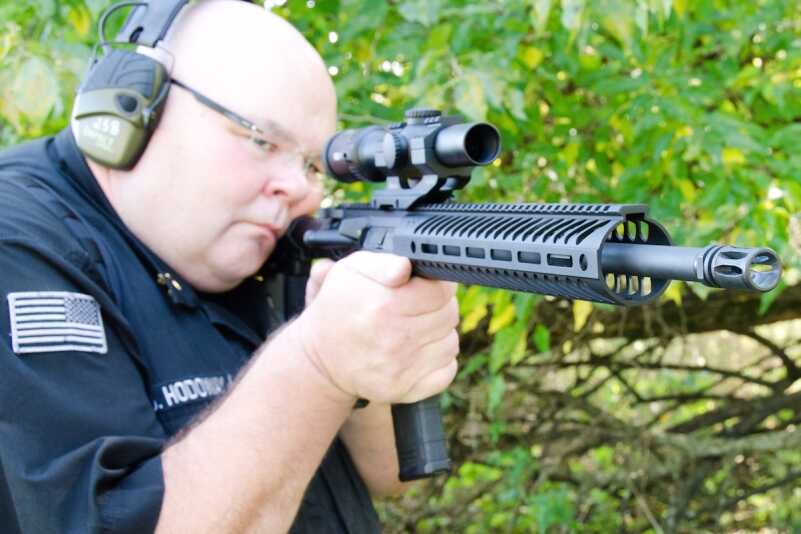
The Seekins Precision G.I. rifle from Freedom Munitions combines top-notch quality and features with a sub-$1,000 price point.
To learn more, visit https://www.freedommunitions.com/firearms/rifles/seekins-precision-gi-rifle/ar-15-223-seekins-rifle-kit.html.
To purchase a Seekins product on GunsAmerica.com, click this link: https://www.gunsamerica.com/Search.aspx?T=SEEKINS.
I was recently sent a gun from a company that I had previously only purchased ammunition from, which was interesting. The good people at Freedom Munitions had formed a partnership with their neighbors, Seekins Precision, in Lewiston, Idaho. Seekins has a great reputation as a quality boutique manufacturer of AR parts and complete rifles. The cool product of this partnership is that Freedom Munitions is now stocking what they call the G.I. Rifle, which has all the best options that Seekins offers for around a grand! The exciting part is that they have this rifle in stock now, ready to ship to your FFL.
What makes the G.I. rifle so unique is the fact that Seekins Precision rifles are usually not “price point” products. Seekins has a great reputation for quality, and prices their rifles at reasonable ranges for the quality you are receiving. But, these prices often range from above $1,500 (with some around $1,250 at the lowest). So, the sub-$1,000 ballpark price of the G.I. is notable. Sure, $949.50 is still a lot of money, but you get a lot for that money with this rifle that makes it a real value, in my opinion. Read on to find out more.
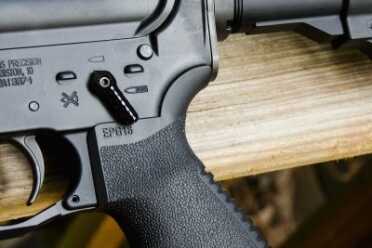
The rifle was equipped with the optional 60-degree ambidextrous safety lever, which the author liked.
Unboxing
The GI Rifle came in a plastic hard case precut outlined in the Mil-spec high-density 2.2-lb. polyethylene to match the rifle and all the accessories. Also included were three Freedom Munitions-branded AMEND2 30-round magazines (one comes standard with the rifle). These magazines were black polymer with a textured grip, anti-tilt follower and stainless steel spring. The magazines can be painted with Cerakote.
The rifle has a 16-inch barrel with a twist rate of 1:8, is chambered in .223 Wylde (which means that it can shoot both 5.56x45mm and .223 Remington) and has an ArmorBlak coating. From what I can tell, ArmorBlak is a durable coating that, unlike Melonite, will not affect the heat treatment of the metal. The barrel was capped off with a A2X Flashhider, threaded at 1/2x 28. Covering the barrel was the beautiful 12-inch Seekins Precision MCSR M-LOK Free Float Handguard. This is a traditional gas-operated gun, featuring an M16 bolt carrier group and an M4 feed ramp. The upper receiver has a Mil-Spec 1913 Picatinny rail feeding into the matching rail on top of handguard.
The buttstock on the rifle is the Battlelink Minimalist MilSpec adjustable stock from Mission First Tactical. The stock is made from military-grade reinforced, super-tough polyamide. This makes for a very strong yet incredibility light stock. The pistol grip, also from Mission First Tactical, feels good in the hand and has storage in the grip for kit of your choice.
Housed within the lower receiver is a milspec standard trigger. The selector switch is fully ambidextrous and offers you the choice between a 90-degree standard throw lever and a 60-degree short throw lever. My sample rifle was set up with the 60-degree option. The selector has a diamond texture added that aids in maintaining contact with the lever, and it has the added benefit of looking great. The trigger guard is oversized and uniquely-shaped to add to the appearance and facilitate the use of gloves. The bolt catch is the Seekins oversized catch with an aggressive diamond texture for positive operation. Locking the bolt back is facilitated by the bottom portion of the catch, which is also oversized and diamond textured for this reason. Even the mag release button, billet CNC machined from a solid piece of aluminum, is diamond textured to match the other controls.
So, it should be clear by now that while the G.I. rifle has an introductory-level price point, it is very well-appointed on enhancements and feature upgrades. This is not a bone-stock M4-style carbine, but a nicely appointed little rifle.
Let’s Be Clear
The following is a clarification to avoid confusion, not necessarily a point of criticism. The G.I. Rifle’s upper and lower receiver are CNC made from 7075–T6 aluminum forgings. This is not a complaint, but I want to clarify this, as Seekins is best-known for their very creatively-machined billet receivers. Both the selector switch and bolt catch are manufactured using metal injected molding (MIM). They claim that this allows for the selection of a proprietary material that is considerably stronger than billet or factory milspec.
Now, for my opinion: All of the AR-15 style guns that I currently own are manufactured using an aluminum forging. I have never had an issue with this material. I do believe that the billet is a stronger, more durable base to build the gun from. However, on this platform I believe that its advantage is primarily to allow for a higher, more detailed level of artistic customization. I have had some less-than-spectacular results with MIM parts, and as a rule I generally try to avoid them. That being said, I am not in the manufacturing business, nor am I any class of an engineer. I will defer to others who’ve told me that it is quite probable that the claims made about the process and materials are completely accurate in regards to producing a better part using MIM over machining from billet.

The G.I. has all the features you want from an AR and none that you do not, and all at a great price.
SPECS
- Chambering: .223 Wylde
- Barrel: 16 inches
- OA Length: 30-34 inches
- Weight: 7.3 pounds
- Stock: Battlelink Minimalist
- Sights: None (Picatinny rail)
- Action: Direct gas impingement
- Finish: Matte black
- Capacity: 30+1
- MSRP: $949.50
Range Prep
The GI Rifle did not come with optic or sights installed, and I wanted to choose an optic that reflected the potential of this gun. To that end I mounted up the MeOpta Meostar 1-6X24 RD with a 30mm main tube. I selected this optic due to its impressive 113-foot field-of-view at 100 yards. It also came with windage and elevation turrets that offered easy adjustments. The illuminated red dot in the center had eight levels of intensity to choose from. Each of these eight settings are followed by an intermediate off position, so that the dot can be turned off and back on without having to cycle through all of the options to return to your preferred level of brightness. Nice! I found that it had plenty of power for daylight use, and the adjustment allowed for use in the faintest amount of ambient light.
The reticle in this scope is the K-Dot 2, which features a dot in the center framed by horizontal and vertical guidelines. I found that this setup allowed me to bring my eye quickly to the center of the scope. With the magnification set at 1X, this essentially functioned as a red dot optic, allowing me to shoot with both eyes open. The magnification can be dialed up to a power of 6X as needed for performance at longer ranges.
The Meostar 1-6X24 RD was just an incredible scope on all levels. I intend on using this optic as a hunting scope, for self-defense and even for competition shooting. With the clear glass and excellent light-gathering ability, this is a remarkable optic.
Since I had received this rifle from Freedom Munitions, I thought it would only be appropriate to shoot some of their remanufactured .223 55 grain FMJ through the gun. I also grabbed some Black Hills 5.56 77 grain Open Tip Match (OTP) as well as some Aguila 62-gr. FMJBT ammo.
On the Range
Upon arriving at the range, I wanted to zero the scope on the rifle. I had done a bore sighting, so I knew that I would at least be on paper to begin with. To start off, I was using the Freedom Munitions 55-grain FMJ. As usual, the first few rounds were major adjustments, with the subsequent rounds and adjustments becoming progressively smaller. However, I couldn’t quite reach the point where I felt like the rifle was really fine-tuned and dialed in. It seemed as if there was some kind of wandering zero, or perhaps that the scope wasn’t securely mounted to the rifle. I was just about ready to pack the rifle up and head home when I decided to try one more variable, and that was the ammunition.
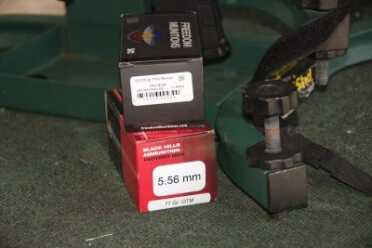
The author ran both some remanufactured Freedom Munitions 55-grain ammo as well as some Black Hills 77-grain match ammo through the rifle.
I switched to the 77-grain Black Hills and instantly the rifle began to reveal its true potential. At 100 yards my next three shots, although they did not impact the center of the target, were less than an inch apart and there were only two holes for the three shots! I began to realize that I had cracked the code, and it was apparent to me that the Freedom Munitions loads were simply not capable of producing the accuracy that the rifle could. I went back and analyzed my previous work with the Freedom Munitions rounds and discovered that I was getting about a 3-inch group at 100 yards. But, bear in mind that this is not designed to match ammunition, but rather good remanufactured range and practice loads.
Now that I had the rifle well and truly zeroed, I set about determining the overall functionality of the gun. As I’ve said many times before, a gun that truly works well is more than just the sum of its parts. First and foremost, I noticed the 60° short throw selector was a pleasure to run, although I do believe that this is going to be one of those love it or hate it features. To me, it was faster and provided a better sense of control than I typically experience with a 90° selector. I plan on installing this on some of my other rifles soon. The other two controls were certainly an improvement over the standard fare, but not quite as pronounced as the selector. The magazine release was an extended version with their diamond texturing, and I found it easy to manipulate without inadvertently dumping a magazine on the ground. The bolt catch/release lever was easy to operate, and provided a superior feel and function as well.
 The magazines that came with the gun ran without a single malfunction, and appeared to be sufficiently durable. They don’t particularly have any defining features that set them apart from most of the other high-quality polymer magazines on the market today. I also ran a variety of metal and polymer magazines through the gun, and none of them had any issues.
The magazines that came with the gun ran without a single malfunction, and appeared to be sufficiently durable. They don’t particularly have any defining features that set them apart from most of the other high-quality polymer magazines on the market today. I also ran a variety of metal and polymer magazines through the gun, and none of them had any issues.
I took this gun to the range several times, and each time the gun performed at 100%. Mind you, there was no cleaning or maintenance done between trips. When I finally took the gun apart for photography, it was obvious that this gun was not some sensitive Sally; it was built for serious purposes.
[one_half]
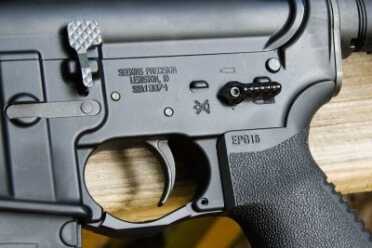
The G.I. rifle, despite its low price, comes with several upgrades/enhancements such as an enlarged trigger guard and specially textured bolt catch lever.
[/one_half]
[one_half_last]

For those on a budget (like an LE officer buying his own weapon), the G.I. offers a lot of bang for the buck.
[/one_half_last]
Final Thoughts
As they say, you get what you pay for—or at least you should. There are probably a few people out there who are going to tell me what all this-and-that they could get for $949.50, and how this gun is not a good value, etc. Well I’m putting my money where my mouth is on this one: I sent the folks at Freedom Munitions a check for this particular gun. This G.I. Rifle is light, reliable, and accurate, and it has some innovative controls. Make no mistake, there are certainly cheaper guns out there, and I own a few. There are more expensive guns out there, too, and I own a few of those. Nevertheless, I’m hard-pressed to find a better value in this price range on the market today.
To learn more, visit https://www.freedommunitions.com/firearms/rifles/seekins-precision-gi-rifle/ar-15-223-seekins-rifle-kit.html.
To purchase a Seekins product on GunsAmerica.com, click this link: https://www.gunsamerica.com/Search.aspx?T=SEEKINS.

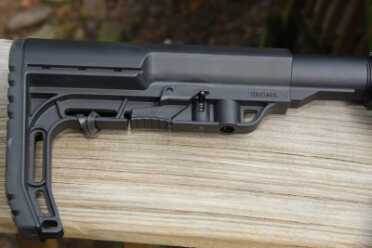

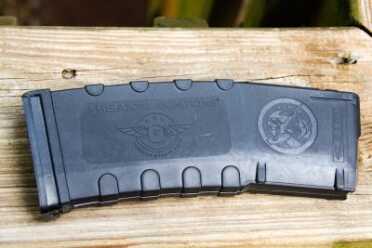
Good article. Learned about the rifle and that I need to try heavier bullets in my AR. Thank you.
Nice article Jon. I’ve been curious about these since they started showing up in my regular ammo sales emails from Freedom. I’ve always been a fan of Seekins and it looks like this one’s a winner. I buy ammo from Freedom just about every month and have rarely had any issues. I’ve noticed the same thing you experienced with their cheap remans, it’s never the most accurate and twist rate doesn’t seem to matter for me. That being said, for the cost and what I use it for, I couldn’t be happier. I buy their 223, 300, 45, 40 and 308 and will continue to do so without hesitation.
nobody says what the barrel steel is? 4140 or 4150?
Nice looking rifle. I enjoy reading the reviews but as I have had the opportunity to shoot a greater variety of AR “brands” including Ruger, DPMS, Radical Firearms, Huldra/Anderson, Colt, HK and Frankenstein (personal builds), I have a hard time understanding the hype about guns costing $1,500 and up. I realize that this article is talking about a $950 gun, but it comes from a company known for ones costing much more. Shooting out to 110 yards (current max at my range) I have had no problem putting shots consistently 1 MOA…and this includes a $499 Radical Firearms 7.62x .39 AR using a budget-conscious Bushnell AR series scope 4.5×18-40. Most of these use MIM parts…so what? I have never had a failure with any part in shooting AR’s from any manufacturer. The only failure is a scope mount that loosens over the course of shooting many rounds. Blue Lock Tite and problem fixed. The trigger and charging handle is about the only thing I would change if I were making upgrades for performance or ease of use. If you have the money and love to part with it, go ahead and buy a $2-$3000 gun. If you’re more fond of your money, go buy a $500-700 AR like the Ruger 556 and you won’t be disappointed. You’ll have more money for optics and ammo!
So you take a sub $1000 rifle and test it with a $1,500 scope. Good combination, makes sense. NOT.
Bill-
I except that it may not make sense to you to put a scope that retails for $1.500 on this rifle. There are deals out on the web for $999.00 on this optic. I wanted an optic equal to the gun, this is a 1-6 that allows for the full range of the gun from CQB (red dot range) to full distance. I have experienced more cheap optic fail than cheap rifles. Your mileage may vary.
Thanks for reading the article hope you enjoyed it.
Jon
I was tought your optics should cost double the gun it’s on if it’s a 2500$ shooter then night force US optics and some luepold M6 up
You’re comment makes no sense. What difference does the quality/price of someone’s scope pick matter to you? If he wants to put a $5000.00 scope on it, it should really concern you, not even one little tiny bit. My suggestion to you, would be to try and find a life A.S.A.P. and stop sweating the petty stuff.
1:8 Barrel twist rate and 55 grain projectiles is not a great match as seen with the improvement when using the 77 grain. I’m sure a portion of the improvement was the weight and the rest from The quality of Black Hills ammo.
I’m pretty hard on my guns (like drop it when “winchester” or urgent requirement to transition to rifle), never had a MIM part break. I know many shooters swap out MIM parts asap, to each their own choice. You ever see those prolonged torture tests? Ever see a MIM part fail during one? Don’t get me wrong, I know that occasionally a MIM part fails. If its not on your CC, house, truck or bugout gun, don’t sweat it.
Will Drider
Great point on the AMMO!
Jon